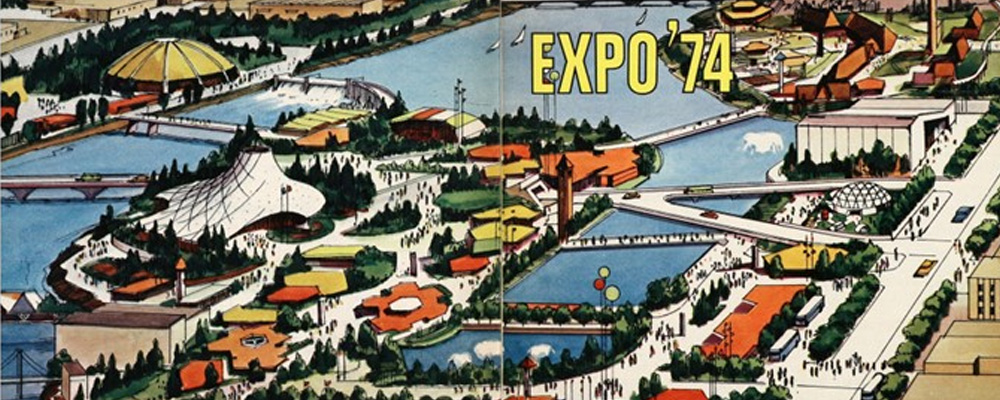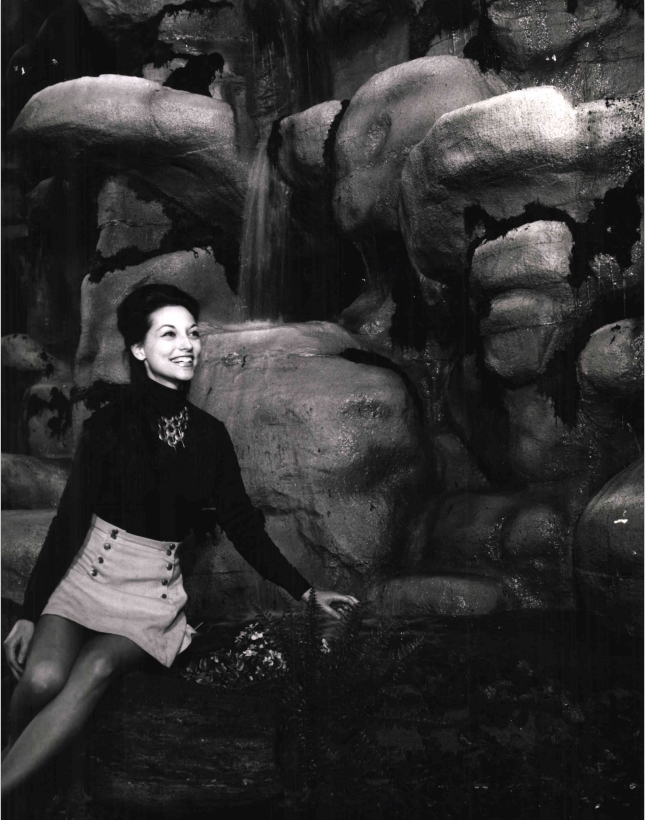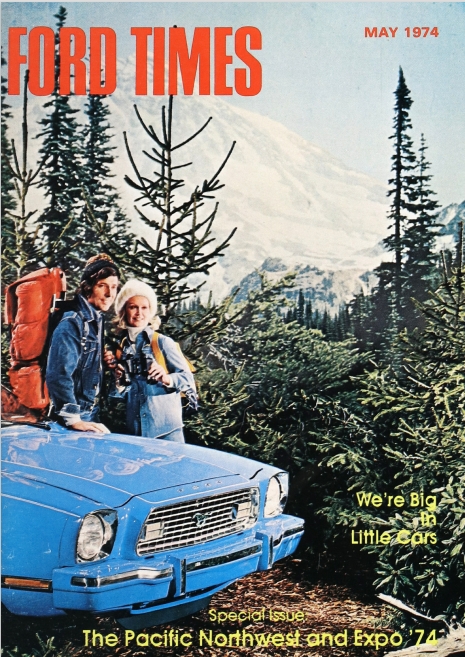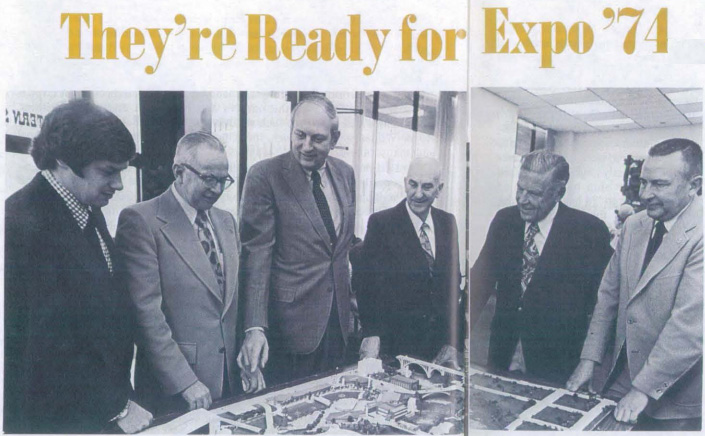
50 years ago, Spokane, Washington played host to a groundbreaking event that transformed the city into what it is today. As we mark the 50th anniversary of Expo ’74, Spokane’s landmark achievement, it’s time to reflect on the significant impact this event had on the city and check out some of the contributions that made the fair a success.
The Legacy of Expo ’74 – A Fair to Remember
Held in Spokane, WA, Expo ’74 opened on May 4, 1974, and ran until November 3, 1974, drawing attention and visitors from around the world. The official theme, “Celebrating Tomorrow’s Fresh New Environment,” brought attention to the need of urban renewal and environmental conservation. Focusing on an ecological and green theme was right for the times. “Not only was the environment a hip and progressive topic, but it also seemed an ideal theme for a fair with a spectacular waterfall running through its middle.” Expo ’74: Spokane World’s Fair – HistoryLink.org
With previous world fairs held in much larger cities than Spokane, some thought the undertaking was impossible. In 1959, Spokane Unlimited was created. The organization consisted of downtown businesses and property owners with the goal of revitalizing the downtown area. Next, the group hired EBASCO Services, Inc., a New Your consulting firm, to create an urban renewal plan. Included in the plan was recommendations on how to pay for the renovations. Yet voters defeated bond issues in 1962 and 1963. Next came the hiring of King Cole with his urban renewal and planning experience. Cole began his work by creating a citizen’s group, Associations for a Better Community, ABC, to partner with Spokane Unlimited. But how to obtain the downtown property from the railroads and other owners was daunting.
During this time, Spokane was thinking about a centennial celebration to commemorate their founding in 1873. Yet there were concerns about cost-effectiveness and long-term benefits. For Spokane to make improvements to its aging infrastructure that would revitalize and last for many years to come, something more drastic needed to take place. Enter an international event: hosting an Expo. The project would propel the city into the future with meaningful and enduring improvements, a lasting legacy far beyond a celebration. Money was raised, legislature passed and a B&O tax voted in. In October 1971, President Richard M. Nixon gave his stamp of approval.
Through negotiations, construction, beautification and many doubts, President Nixon opened the fair on May 4, 1974. The fair transformed Spokane with urban development projects that rejuvenated the downtown area, reforming it into a public park. The event covered 100 acres, cleaning up railroad tracks, trestles and warehouses. The most significant transformation was the conversion of a rail yard and industrial ground into a public space that lives now as the beautiful Riverfront Park. The cleanup allowed for Spokane’s spectacular natural resources to be seen front and center, the scenic Spokane River and the enthralling Spokane Falls.
Facts:
- Spokane, population 170,000, was the smallest city at the time to ever host a World’s Fair. “The little town that could, showed the world it did.” Center for the Study of the Pacific Northwest (washington.edu)
- The opening ceremony was attended by 85,000 people.
- The world fair attracted 5,187,826 visitors.
- The 155-foot clocktower of the Great Northern depot remained. The diameter of each of the four clock faces measure nine feet in diameter. “It would immediately become one of the most-recognized symbols of the fair, and of the city itself.” Expo ’74: Spokane World’s Fair – HistoryLink.org
- The Soviet Union had not participated in a world’s fair since 1939-1940. Their 54,500-square foot pavilion covered more space than all the pavilions combined at the Seattle’s World Fair in 1962.
The Fair and Its Pavilions
The fair hosted participants from around the globe, including countries, states and corporations, each contributing their insights and innovations toward the promotion of a healthier environment.
Ten countries from around the world participated, including the United States, Canada, Japan, Australia, the Soviet Union, Korea, China, Germany, Iran and the Philippines. The various pavilions showcased natural resources, advancements in recycling and environmental projects.
United States Pavilion
The pavilion of the U.S., 179,250 square feet, stood out as a prominent and iconic structure. As the largest pavilion, it was covered by a 14-story tall steel mast with the theme “Man and Nature: One and Indivisible.” “In keeping with the environmental theme of the show, the structure was built to resemble a giant tent, with grass and trees on the inside. Totem poles were displayed as a symbol of the continent’s past, and visitors were shown displays about the environmental concerns of the day.” The United States Pavilion – Expo ’74 and Riverfront Park Tour – Stop 11 | Spokane Historical
A big attraction was an IMAX theatre. Showings included views of the Grand Canyon and high-speed motorcycle races. “Barf bags” were provided just in case viewers got sick from the stomach-churning scenes. The theatre was later demolished in 2018 to make room for the redevelopment of Riverfront Park.
States contributing to the event included the host state, Washington, the biggest state site, showcasing its leadership in environmental initiatives, including its pioneering recycling program and policies aimed at preserving its rich natural landscapes. The structure is now the Spokane Convention Center. Other states participating were Oregon, Idaho and Montana
Many corporations joined, showcasing their commitment to environmental stewardship and innovative technology. Notable corporations at the Expo: Ford, General Motors, General Electric, Eastman Kodak, IBM, Westinghouse, Kaiser Aluminum, the Singer Company and the Bell systems.
Ford Motor Company Pavilion
Ford’s exhibit site was located on the south side of the Spokane River at what is currently known as Red Wagon Meadow. It was housed in a geodesic dome 120 feet in diameter and 45 feet high. The overall theme was “Sharing the Environment” and included a manufactured mountain with seven waterfalls and a stream that would circulate the pavilion. “Display elements range from an original Indian dugout canoe, and an actual “covered wagon” used by early American settlers, to a motorized pogo stick that has the look of tomorrow.” 04/30/74-Ford News Release-Expo 74 Ford opening with world’s largest scissors

Ford erected a small theater and depicted an environmental film, “Mother Earth, Father Sky,” emphasizing to share the environment in a smart way and how to gain appreciation from the natural beauty around us. Throughout the pavilion, several mini-theaters showcased films, including one featuring the Model T equipped with a camping tent and another highlighting Ford’s future role in transportation. Ford also promoted the great outdoors utilizing their vehicles, “outdoor pleasure and enjoyment are provided with luxury and comfort in this 1974 Mercury Montego MX Villager station wagon.” Expo ‘74: From Pleas to Save Nature To Sales Pitches for Vehiculer Fun – The New York Times (nytimes.com)
A fun fact: Also displayed was an item from founder Henry Ford. “A nostalgic item looks back on the days of the company’s founder. It’s a unique “Lazy Susan,” which was used to serve food during Henry Ford’s outings of 50 or 60 years ago with such friends as Thomas A. Edison, Harvey S. Firestone and occasionally, President Warren G. Harding. Unlike the familiar present-day Lazy Susan for holding relishes at house parties, the one on exhibit is a portable camping table nine feet in diameter and capable of seating 15 people! Mr. Ford and his fellow campers had their plates set on the larger-diameter lower tier, and revolved the smaller upper tier to pass food and liquids. This Lazy Susan is on loan from the Henry Ford Museum in Dearborn, Mich.” 05/03/74-Ford News Release-Expo 74 display elements from the past
In May 1974, Ford Times magazine saluted the Northwest by featuring a special issue, “The Pacific Northwest and Expo ’74,” dedicated to Expo ’74, offering readers an in-depth look at the world’s first environmentally themed world’s fair. This edition was particularly notable for including an article written by Bing Crosby, who grew up in Spokane and brought personal insight and hometown pride to light. Click to read the magazine in full.

If you’re a historian or a Ford enthusiast, you’ll find the Ford collection on Expo ’74 historical documents particularly fascinating. These archival materials offer a unique glimpse into how the event was presented. The documents, provided by Ford Motor Company, offer invaluable insights into Ford’s role in the historical event.
Wendle Ford and the Ford Pavilion

Photo used with permission from Ford Motor Company.
The involvement of Ford Motor Company in Expo ’74 can be largely attributed to the proactive efforts of the Spokane Ford Dealer Community Relations Committee. Chairman Frank Eichelberger played a pivotal role in ensuring Ford’s participation in the event. He acted as spokesman for local businessmen: Chud Wendle, president of Wendle Ford Sales, Inc., H.D. Richardson, president of McCollum Ford Sales, Inc., James Sutherland, president of Sutherland Lincoln-Mercury Inc., and Donald Adams, Jr., president of Adams Tractor Company (Ford). The group noted that Ford’s participation would help the company reach a broader audience in which to share their commitment to innovation in transportation, while bolstering their image in the Spokane community. Ford agreed!
Fair Events
Along with the central theme of environmental preservation, the fair hosted a variety of attractions and activities for its visitors from around the world.
Music
There were concerts almost every day, held in the Spokane Opera House. Some of the entertainment included:
- Liberace
- Bill Cosby
- Bob Hope
- Jack Benny
- The Pointer Sisters
- Helen Reddy
- The Carpenters
- Grand Funk
- Bachman-Turner Overdrive
- Merle Haggard
- Buck Owens
- Van Cliburn
- Chicago
- Charley Pride
- Ella Fitzgerald
- Marcel Marceau
- Victor Borge
- Margot Fonteyn and the London Ballet
- Isaac Stern
- Itzhak Perlman
- The Moiseyev Dancers of Russia
- The National Dance Company of Senegal
- Festa Brazil
- Republic of China Acrobat Spectacular
- Georgian State Dancers and Singers
- Japanese Folkloric Dance Company
- Royal Shakespeare Theatre with Sir Michael Redgrave and Dame Peggy Ashcroft
Rides
One of the standout attractions at Expo ’74 was the enclosed Gondola ride that brought guests across the Spokane Falls. As the passengers rode over the Falls, they could see the raw power of nature, so close that the spray would moisten the windows. The fair also offered the Sky Ride, a two-person chair lift. Riders saw a unique aerial view of the entire fairgrounds and the scenic beauty around them. It served as a practical mode of transportation, allowing guests to travel from one end of the fair to the other.
Amusement Areas
An amusement park added a layer of fun and excitement, appealing to families and younger visitors. The park featured a roller coaster from Germany and a Ferris wheel from Italy.
Food
Expo ’74 was not just a showcase of environmental innovations and cultural performances, but also a celebration of global cuisine. Some of the delightful culinary offerings included:
- Bavarian Gardens
- French
- Soviet
- Japanese
- Indian
- Philippine
- Canadian
- Mexican
- Chinese
- Italian
- and more
Remembering and Celebrating/Commemorating 50 Years
The 50th anniversary of Expo ’74 is an opportunity for Spokane to reflect on its growth and environmental strides it has made since 1974. The city has lined up a series of events that pay homage to its historic World’s Fair. The celebration not only commemorates the past but also looks forward. Some of the planned activities:
Opening Celebration
- Location: Riverfront Park
- Date: May 4, 2024
- Learn about Spokane’s history, partake in recreational activities and see what is coming during the celebration occurring over the next nine weeks. Includes a concert tribute to Earth, Wind and Fire.
Spokane Indians Celebration
- Location: Avista Stadium
- Date: May 4, 2024
- Join the Spokane Indians as they celebrate Expo ’74 with specialty jerseys and fireworks.
Echoes of Expo
- Location: Riverfront Park
- Date: May 4th to July 7th
- Experience the history of Expo ’74 through audio recordings.
Historic Timeline Outdoor Exhibit
- Location: Pavilion at Riverfront Park
- Date: May 4th to July 4th
- Walk through history with an outdoor timeline exhibit. Presented by The Spokesman-Review.
Community Stage
- Location: Riverfront Lilac Bowl
- Date: Every Saturday, May 4th to June 29th
- Experience weekly performances by local and regional acts, arts and cultural organizations, local tribes and educational institutions. Also, enjoy family-friendly activities, food trucks and artisan vending.
Closing Ceremonies
- Location: Riverfront Park
- Date: July 4, 2024
- Join the Spokane Symphony for a 4th of July concert and fireworks.
The Lasting Impact on Spokane
The Expo 1974 was a pivotal event not only in terms of its cultural and social significance but also for its lasting impact on urban development and environmental consciousness in the city. The World’s Fair reshaped Spokane’s landscape, bolstered its economy and strengthened its community spirit.
Perhaps the most significant change was the revitalization of Spokane’s riverfront area. Before the expo, it was an industrial zone with rail yards and warehouses. Hosting Expo ’74 spurred the city to reclaim the riverside property and transforming it into a vibrant public space. Today, Riverfront Park remains a central and beloved green space in downtown Spokane, offering walking trails, performance spaces and scenic views, continuing to attract residents and tourists.
As we celebrate this milestone, we also look forward to the future of Spokane. The city continues to grow, with an eye on sustainability that was highlighted by Expo ’74. The fair’s influence is a continuous reminder of the power of vision, urban planning and community togetherness. “If there’s an enduring lesson, beyond the physical aspect of having that park and having a river released from the burden of railroad tracks over it, it’s the lesson that people working together can do pretty amazing things.” EWU historian Bill Youngs, Inlander 04/04/2024 by The Inlander – Issuu
Spokane History with Wendle Ford
Spokane stepped onto the world stage hosting Expo ’74. Wendle was there, celebrating our community spirit. Since starting our operations in 1943 and continuing to this day, we stand as a testament of how history influences our future. Thriving in the Inland Northwest, Wendle represents a connection to Spokane’s past as well as its ongoing progress toward regional vitality. The legacy of Expo ’74 is deeply integrated into Spokane’s identity. We are proud to join the city in celebrating both its rich history and its promising future.
Sources:
- Expo ’74: Spokane World’s Fair – HistoryLink.org
- Expo 50 | Spokane (visitspokane.com)
- May marks when Spokane’s audacious urban renewal project came to life — now 50 years after, Expo continues to define the city by the falls | Columns & Letters | Spokane | The Pacific Northwest Inlander | News, Politics, Music, Calendar, Events in Spokane, Coeur d’Alene and the Inland Northwest
- Spokane “Expo 74” (americasbesthistory.com)
- GU Planning Events, Efforts to Commemorate Expo ’74’s 50th Anniversary | Gonzaga University
- Heather Foley explains the harrowing odyssey which landed Expo ’74 in Spokane | FOX 28 Spokane
- ‘Garbage Goat’ and ‘Governor Evidence’ mark 50 years of Expo ’74 – MyNorthwest.com
- Vintage Spokane: Expo ’74
- Center for the Study of the Pacific Northwest (washington.edu)
- From the Archives: Expo ’74 – May 2, 2014 | The Spokesman-Review
- Spokane Historic Preservation Office » Riverfront Park History 1970 (historicspokane.org)
- Riverfront Park IMAX in Spokane, WA – Cinema Treasures
- IMAX Demolition Moved Up in Schedule, Begins Jan. 29, 2018 – City of Spokane, Washington (spokanecity.org)
- Expo ’74: 50th Anniversary Celebration – Spokane County Library District (scld.org)
- 50 years ago, The World’s Fair helped reshape Spokane’s downtown | Crosscut
- Ford Motor Company — Visit Expo ’74 (squarespace.com)
- Expo ‘74: From Pleas to Save Nature To Sales Pitches for Vehiculer Fun – The New York Times (nytimes.com)
- official-site-map.pdf (worldsfairphotos.com)
- The United States Pavilion – Expo ’74 and Riverfront Park Tour – Stop 11 | Spokane Historical
- U.S. Pavilion built for Expo ’74 – Dec. 26, 2019 | The Spokesman-Review
- Inlander 04/04/2024 by The Inlander – Issuu
- Ford historical documents




